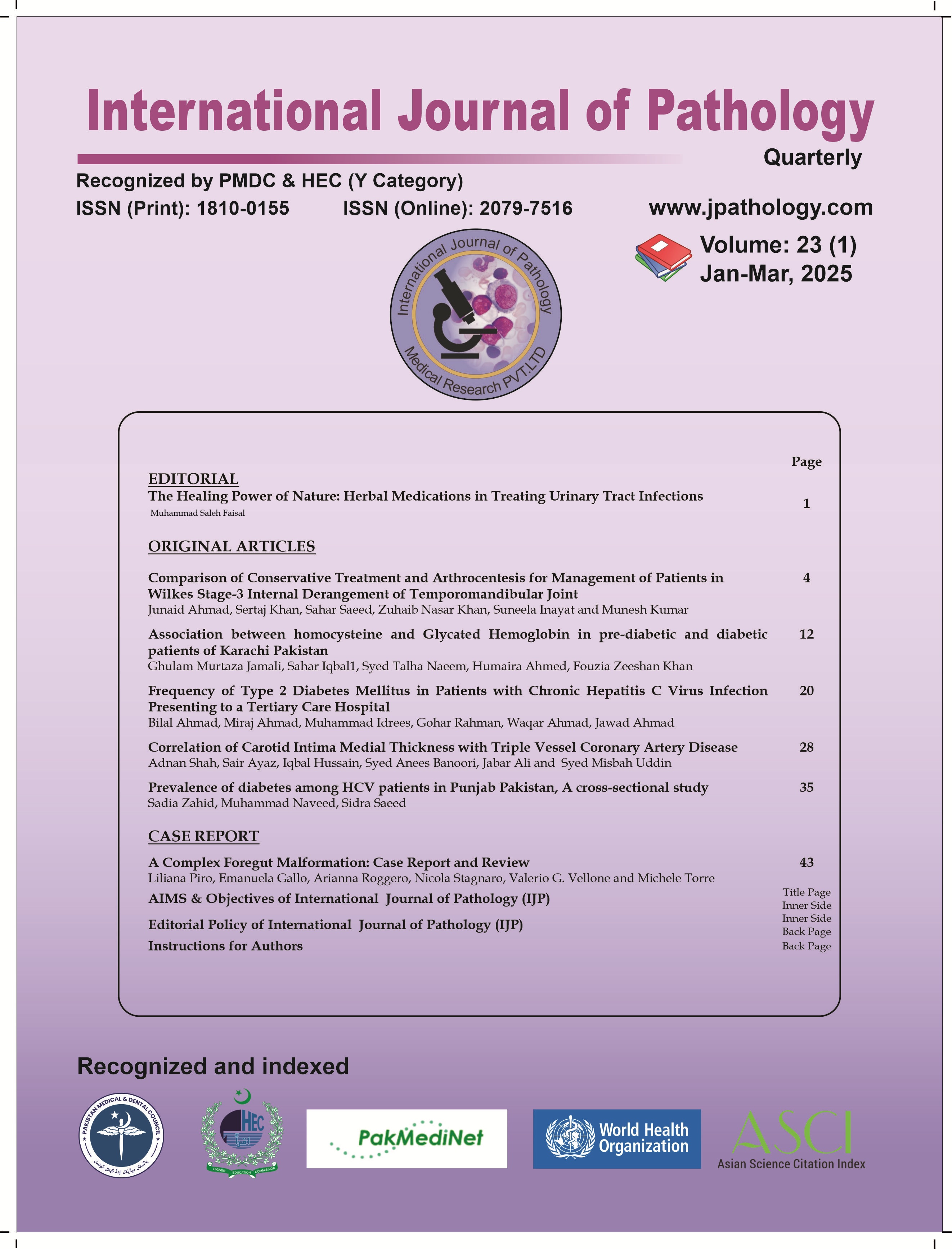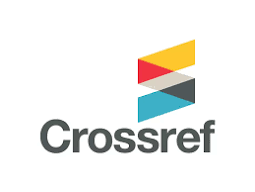Correlation of carotid intima medial thickness with triple vessel coronary artery disease
DOI:
https://doi.org/10.59736/IJP.23.01.944Keywords:
Atherosclerosis, Carotid Ultrasound, Coronary Artery Disease, Cardiovascular RiskAbstract
Background: Coronary artery disease (CAD) is a leading cause of morbidity and mortality, with triple vessel disease (TVD) representing a severe and complex form. Carotid Intima-media thickness (CIMT) is a non-invasive marker of subclinical atherosclerosis and has been associated with cardiovascular risk. The aim of our study was to investigate the correlation between CIMT and TVD in patients at Lady Reading Hospital, assessing CIMT as a potential predictor for TVD.
Methods: A cross-sectional study was conducted at the Department of Cardiology, MTI/Lady Reading Hospital, from June 1, 2023, to December 1, 2023. Seventy-four patients aged 30 to 70 years with a confirmed diagnosis of TVD were included using non-probability consecutive sampling. IMT was measured via B-mode ultrasound at six carotid artery sites. Pearson’s correlation coefficient was used to assess the relationship between CIMT and TVD, with stratification by age, gender, BMI, and disease duration.
Results: The mean age of participants was 52.15 ± 5.617 years, with 74.3% males. TVD correlation was present in 62.2% of patients. Abnormal CIMT (>1 mm) was observed in 75.7% of participants. There was a significant positive correlation between CIMT and TVD (r = 0.312, p < 0.05), with stronger associations in older patients (r = 0.367) and females (r = 0.406).
Conclusion: Increased CIMT is significantly correlated with the presence of TVD, suggesting its potential role in risk stratification for severe CAD particularly in older patients. These findings highlight the utility of CIMT as a non-invasive predictor for TVD, emphasizing the need for early screening and the targeted interventions for high-risk patients.
References
Jagannathan R, Patel SA, Ali MK, Narayan KMV. Global Updates on Cardiovascular Disease Mortality Trends and Attribution of Traditional Risk Factors. Curr Diab Rep. 2019 Jun 20; 19(7):44. Doi: 10.1007/s11892-019-1161-2. PMID: 31222515.
Serruys PW, Morice MC, Kappetein AP, Colombo A, Holmes DR, Mack MJ,ety al. Percutaneous coronary interventions versus coronary-artery bypass grafting for severe coronary artery disease. N Engl J Med. 2009 Mar 5;360(10):961-72. doi: 10.1056/NEJMoa0804626.
Gupta AK, Paterson HS, He C, Vallely MP, Bennetts JS. Triple Vessel Coronary Artery Disease Needs a Consistent Definition for Management Guidelines. Journal of Cardiac Surgery. 2023;2023:6653354. doi: 10.1155/2023/6653354.
Naessen T, Einarsson G, Henrohn D, Wikström G. Peripheral Vascular Ageing in Pulmonary Arterial Hypertension as Assessed by Common Carotid Artery Intima Thickness and Intima/Media Thickness Ratio: An Investigation Using Non-Invasive High-Resolution Ultrasound. Heart Lung Circ. 2023 Mar;32(3):338-347. doi: 10.1016/j.hlc.2022.10.017.
Kappetein AP, Dawkins KD, Mohr FW, Morice MC, Mack MJ, Russell ME,et al.. Current percutaneous coronary intervention and coronary artery bypass grafting practices for three-vessel and left main coronary artery disease. Insights from the SYNTAX run-in phase. Eur J Cardiothorac Surg. 2006 Apr;29(4):486-91. doi: 10.1016/j.ejcts.2006.01.047.
Lekakis, J.P., Papamichael, C., Papaioannou, T.G. et al. Intima–media Thickness Score from Carotid and Femoral Arteries Predicts the Extent of Coronary Artery Disease. Int J Cardiovascular Imaging. Oct 2005; 21: 495–501. https://doi.org/10.1007/s10554-004-8165-x
Polak JF, Pencina MJ, Pencina KM, O’Donnell CJ, Wolf PA, D’Agostino RB. Carotid-Wall Intima–Media Thickness and Cardiovascular Events. N Engl J Med. 2011 Jul 21;365(3):213–21.
Patel, A.P., Wang, M., Ruan, Y. et al. A multi-ancestry polygenic risk score improves risk prediction for coronary artery disease. Nat Med. 2023;29 1793–1803 doi.org/10.1038/s41591-023-02429-x
Bytyçi I, Shenouda R, Wester P, Henein MY. Carotid Atherosclerosis in Predicting Coronary Artery Disease: A Systematic Review and Meta-Analysis. Arterioscler Thromb Vasc Biol. 2021 Apr; 41(4):e224-e237. Doi: 10.1161/ATVBAHA.120.315747.
Abeysuriya V, Perera BPR, Wickremasinghe AR. Regional and demographic variations of Carotid artery Intima and Media Thickness (CIMT): A Systematic review and meta-analysis. PLoS One. 2022 Jul 12;17(7):e0268716. doi: 10.1371/journal.pone.0268716.
Agarwal R, Gadupati J, Ramaiah SS, Babu VG, Jain A, Prakash VS. Carotid Artery Doppler: A Possible Non-invasive Diagnostic Approach to Assessing the Severity of Coronary Artery Disease. Cureus. 2024 Jun 22;16(6):e62886. Doi: 10.7759/cureus.62886.
Khosravi M, Sheikhnia F, Pashaei MR, Karimi-Dehkordi M, Alizadeh-Fanalou S. Association between small dense low-density lipoprotein and carotid intima-media thickness. J Cardiovasc Thorac Res. 2024;16(4):202-210. Doi: 10.34172/jcvtr.33145.
Zyriax BC, Dransfeld K, Windler E. Carotid intima-media thickness and cardiovascular risk factors in healthy volunteers. Ultrasound J. 2021 Mar 11; 13(1):17. doi: 10.1186/s13089-021-00218-6.
Sultan SR, Khayat M, Almutairi B, Marzouq A, Albngali A, Abdeen R, et al. B-mode ultrasound characteristics of carotid plaques in symptomatic and asymptomatic patients with low-grade stenosis. PLoS One. 2023 Sep 13; 18(9):e0291450. Doi: 10.1371/journal.pone.0291450.
Liu FJ, Chen Q, Cheng Y. Noninvasive carotid ultrasound for predicting vulnerable plaques of the coronary artery based on optical coherence tomography images. Quant Imaging Med Surg. 2024 Jan 3;14(1):316-24. doi: 10.21037/qims-23-621. Epub 2023 Nov 13.
Dalan R. Carotid atherosclerosis: an ultrasonographic window for subclinical atherosclerotic cardiovascular disease [dissertation]. Singapore: Nan yang Technological University; 2024. Available from: https://hdl.handle.net/10356/175011
Ling Y, Wan Y, Barinas-Mitchell E, Fujiyoshi A, Cui H, Maimaiti A,et al. Varying Definitions of Carotid Intima-Media Thickness and Future Cardiovascular Disease: A Systematic Review and Meta-Analysis. J Am Heart Assoc. 2023 Dec 5;12(23):e031217. doi: 10.1161/JAHA.123.031217.
Li W, Wang Y, Chen S, Zhao J, Su Q, Fan Y,et al. Evaluation of Carotid Artery Atherosclerosis and Arterial Stiffness in Cardiovascular Disease Risk: An Ongoing Prospective Study From the Kailuan Cohort. Front Cardiovasc Med. 2022 May 2;9:812652. doi: 10.3389/fcvm.2022.812652.
Kis M, Yurdam FS. The relationship between degree of coronary artery stenosis detected by coronary computed tomography angiography and ACEF risk score in patients with chronic coronary syndrome. Ann Saudi Med. 2023 Jan-Feb;43(1):35-41. doi: 10.5144/0256-4947.2023.35.
Kapil, C. , Rajasekhar, D. , Vanjakshamma, V. , Kranthichaitanya, D. and Narendra, C. Role of CIMT, eGFR, and Serum HbA1c in Predicting CAD in Non-Diabetic Patients Undergoing Elective Coronary Angiography. World Journal of Cardiovascular Diseases.2018;8: 1-10. Doi: 10.4236/wjcd.2018.81001.
Downloads
Published
Issue
Section
License
Copyright (c) 2025 Adnan Shah, Sair Ayaz, Iqbal Hussain , Syed Anees Banoori, Jabar Ali, Syed Misbah Uddin

This work is licensed under a Creative Commons Attribution-NonCommercial 4.0 International License.
Readers may “Share-copy and redistribute the material in any medium or format” and “Adapt-remix, transform, and build upon the material”. The readers must give appropriate credit to the source of the material and indicate if changes were made to the material. Readers may not use the material for commercial purpose. The readers may not apply legal terms or technological measures that legally restrict others from doing anything the license permits.


